Analysis of High Performance Concrete Mixed with Nano-Silica in Front of Sulfate Attack
Abstract
1. Introduction
2. Materials and Methods
2.1. Materials and Mix Proportions
2.2. Specimen Preparation
2.3. Sulfate Attack Experiment
2.4. Measurements
2.4.1. Mass Test
2.4.2. Elastic Modulus Test
2.4.3. Compressive and Splitting Strength Tests
2.4.4. Scanning Electron Microscope (SEM)
2.4.5. Nuclear Magnetic Resonance (NMR)
3. Results and Discussion
3.1. Mass Change
3.2. Elastic Modulus
3.3. Compressive and Splitting Strength
3.4. T2 spectrum and Pore Size Distribution
3.5. Micro-Surface Morphology
4. Conclusions
- (1)
- The sulfate attack promotes the porosity evolution of HPC, which leads to the decrease of mass, compressive, and splitting strength, resulting in the decline of strength and durability of HPC.
- (2)
- The mixture of nano-silica (NS) in HPC will change the porosity abundance and size, then inhibit the sulfate corrosion on HPC, but this effect is time and concentration dependent.
- (3)
- HPC specimens modified with the concentration of 1% NS exhibit the most effective inhibition of sulfate corrosion, where the mass loss, porosity increment, as well as compressive and splitting strength reduction are minimal after sulfate solution soaking.
- (4)
- The resistance effect response to sulfate attack can be attributed to the pozzolanic activity and filling effect of NS, which fill in the pores and further block sulfate ion infiltration. The agglomeration of nanoparticles at high concentration may be attributed to their decline of effectiveness.
Supplementary Materials
Author Contributions
Funding
Institutional Review Board Statement
Informed Consent Statement
Data Availability Statement
Conflicts of Interest
References
- Dushimimana, A.; Niyonsenga, A.A.; Nzamurambaho, F. A review on strength development of high performance concrete. Constr. Build. Mater. 2021, 307, 124865. [Google Scholar] [CrossRef]
- Xu, F.; Lin, X.; Zhou, A. Performance of internal curing materials in high-performance concrete: A review. Constr. Build. Mater. 2021, 311, 125250. [Google Scholar] [CrossRef]
- Norhasri, M.S.M.; Hamidah, M.S.; Fadzil, A.M. Inclusion of nano metaclayed as additive in ultra high performance concrete (UHPC). Constr. Build. Mater. 2019, 201, 590–598. [Google Scholar] [CrossRef]
- Shen, Y.; Xu, Z.; Tang, M. The process of sulfate attack on cement mortars. Adv. Cem. Based Mater. 1996, 4, 1–5. [Google Scholar] [CrossRef]
- Wang, J.G. Sulfate attack on hardened cement paste. Cement Concrete Comp. 1994, 24, 735–742. [Google Scholar] [CrossRef]
- Song, H.; Chen, J. Effect of damage evolution on Poisson’s ratio of concrete under sulfate attack. Acta Mech. Solida Sin. 2011, 24, 209–215. [Google Scholar] [CrossRef]
- Sathe, S.; Zain Kangda, M.; Amaranatha, G.A. Resistance against sulphate attack in concrete by addition of nano alumina. Mater. Today Proc. 2022, 60, 294–298. [Google Scholar] [CrossRef]
- Neville, A. The confused world of sulfate attack on concrete. Cement Concrete Comp. 2004, 34, 1275–1296. [Google Scholar] [CrossRef]
- Ma, X.; Çopuroğlu, O.; Schlangen, E.; Han, N.; Xing, F. Expansion and degradation of cement paste in sodium sulfate solutions. Constr. Build. Mater. 2018, 158, 410–422. [Google Scholar] [CrossRef]
- He, R.; Zheng, S.; Gan, V.J.L.; Wang, Z.; Fang, J.; Shao, Y. Damage mechanism and interfacial transition zone characteristics of concrete under sulfate erosion and Dry-Wet cycles. Constr. Build. Mater. 2020, 255, 119340. [Google Scholar] [CrossRef]
- Akeed, M.H.; Qaidi, S.; Ahmed, H.U.; Faraj, R.H.; Mohammed, A.S.; Emad, W.; Tayeh, B.A.; Azevedo, A.R.G. Ultra-high-performance fiber-reinforced concrete. Part IV: Durability properties, cost assessment, applications, and challenges. Case Stud. Constr. Mat. 2022, 17, e01271. [Google Scholar] [CrossRef]
- Al-Dulaijan, S.U.; Maslehuddin, M.; Al-Zahrani, M.M.; Sharif, A.M.; Shameem, M.; Ibrahim, M. Sulfate resistance of plain and blended cements exposed to varying concentrations of sodium sulfate. Cement Concrete Comp. 2003, 25, 429–437. [Google Scholar] [CrossRef]
- Chiker, T.; Aggoun, S.; Houari, H.; Siddique, R. Sodium sulfate and alternative combined sulfate/chloride action on ordinary and self-consolidating PLC-based concretes. Constr. Build. Mater. 2016, 106, 342–348. [Google Scholar] [CrossRef]
- ASTM C 452-02 Standard; Standard Test Method for Potential Expansion of Portland-Cement Mortars Exposed to Sulphate. ASTM International (ASTM): West Conshohocken, PA, USA, 2021.
- ASTM C 1202-95 Standard; Standard Test Method for Length Change of Hydraulic-Cement Mortars Exposed to a Sulfate Solution. ASTM International (ASTM): West Conshohocken, PA, USA, 2016.
- ASTM C150/C150M-12 Standard; Standard Specification for Portland Cement. ASTM International (ASTM): West Conshohocken, PA, USA, 2022.
- Talero, R. Expansive synergic effect of ettringite from pozzolan (metakaolin) and from OPC, co-precipitating in a common plaster-bearing solution. Part II: Fundamentals, explanation and justification. Constr. Build. Mater. 2011, 25, 1139–1158. [Google Scholar] [CrossRef]
- Talero, R. Performance of metakaolin and Portland cements in ettringite formation as determined by ASTM C 452-68: Kinetic and morphological differences. Cement Concrete Comp. 2005, 35, 1269–1284. [Google Scholar] [CrossRef]
- Haynes, H.; O’Neill, R.; Neff, M.; Mehta, R.K. Salt weathering distress on concrete exposed to sodium sulfate environment. ACI Mater. J. 2008, 105, 35–43. [Google Scholar]
- Onaizi, A.M.; Huseien, G.F.; Lim, N.H.A.S.; Amran, M.; Samadi, M. Effect of nanomaterials inclusion on sustainability of cement-based concretes: A comprehensive review. Constr. Build. Mater. 2021, 306, 124850. [Google Scholar] [CrossRef]
- Onaizi, A.M.; Lim, N.H.A.S.; Huseien, G.F.; Amran, M.; Ma, C.K. Effect of the addition of nano glass powder on the compressive strength of high volume fly ash modified concrete. Mater. Today Proc. 2022, 48, 1789–1795. [Google Scholar] [CrossRef]
- Hamed, N.; El-Feky, M.S.; Kohail, M.; Nasr, E.-S.A.R. Effect of nano-clay de-agglomeration on mechanical properties of concrete. Constr. Build. Mater. 2019, 205, 245–256. [Google Scholar] [CrossRef]
- Gu, Y.; Ran, Q.; Shu, X.; Yu, C.; Chang, H.; Liu, J. Synthesis of nanoSiO2@PCE core-shell nanoparticles and its effect on cement hydration at early age. Constr. Build. Mater. 2016, 114, 673–680. [Google Scholar] [CrossRef]
- Elahi, M.M.A.; Shearer, C.R.; Naser Rashid Reza, A.; Saha, A.K.; Khan, M.N.N.; Hossain, M.M.; Sarker, P.K. Improving the sulfate attack resistance of concrete by using supplementary cementitious materials (SCMs): A review. Constr. Build. Mater. 2021, 281, 122628. [Google Scholar] [CrossRef]
- Jeon, I.K.; Qudoos, A.; Woo, B.H.; Yoo, D.H.; Kim, H.G. Effects of nano-silica and reactive magnesia on the microstructure and durability performance of underwater concrete. Powder Technol. 2022, 398, 116976. [Google Scholar] [CrossRef]
- Mohamed, A.M. Influence of nano materials on flexural behavior and compressive strength of concrete. HBRC J. 2019, 12, 212–225. [Google Scholar] [CrossRef]
- Mei, J.; Tan, H.; Li, H.; Ma, B.; Liu, X.; Jiang, W.; Zhang, T.; Li, X. Effect of sodium sulfate and nano-SiO2 on hydration and microstructure of cementitious materials containing high volume fly ash under steam curing. Constr. Build. Mater. 2018, 163, 812–825. [Google Scholar] [CrossRef]
- Guo, Z.; Hou, P.; Xu, Z.; Gao, J.; Zhao, Y. Sulfate attack resistance of tricalcium silicate modified with nano-silica and supplementary cementitious materials. Constr. Build. Mater. 2022, 321, 126332. [Google Scholar] [CrossRef]
- Wang, X.; Hou, P.; Yu, J.; Zhou, X.; Cheng, X. The effects of silica fume on C3A hydration. Constr. Build. Mater 2020, 250, 118766. [Google Scholar] [CrossRef]
- Solanki, A.; Singh, L.P.; Karade, S.R.; Sharma, U. Functionality of silica nanoparticles on hydration mechanism and microstructure of tricalcium aluminate. Constr. Build. Mater. 2021, 299, 124238. [Google Scholar] [CrossRef]
- Hou, P.; Wang, X.; Zhou, X.; Cheng, X.; Shah, S.P. Regulations on the hydration, morphology, and sulfate-attack resistivity of C3A with micro/nano-silica particles. Constr. Build. Mater. 2022, 324, 126388. [Google Scholar] [CrossRef]
- Swaidani, A.M. Use of micro and nano volcanic scoria in the concrete binder: Study of compressive strength, porosity and sulfate resistance. Case Stud. Constr. Mat. 2019, 11, e00294. [Google Scholar]
- Mokhtar, M.M.; Morsy, M.; Taha, N.A.; Ahmed, E.M. Investigating the mechanical performance of nano additives reinforced high-performance concrete. Constr. Build. Mater. 2022, 320, 125537. [Google Scholar] [CrossRef]
- Akarsh, P.K.; Shrinidhi, D.; Marathe, S.; Bhat, A.K. Graphene oxide as nano-material in developing sustainable concrete—A brief review. Mater. Today Proc. 2022, 60, 234–246. [Google Scholar] [CrossRef]
- Taylor, O.-D.S.; Abdollahi, M.; Vahedifard, F. Statistical distributions of wave velocities and elastic moduli in near-surface unsaturated soils. Soil Dyn. Earthq. Eng. 2022, 157, 107247. [Google Scholar] [CrossRef]
- Rafael, T. Comparative XRD analysis ettringite originating from pozzolan and from portland cement. Cement Concrete Res. 1996, 26, 1277–1283. [Google Scholar]
- Ministry of Construction of the People’s Republic of China. Standard for Mechanical Properties Test Methods of Ordinary Concrete (GB/T 50081-2002); China Architecture Industry Press: Beijing, China, 2003.
- Fallah, S.; Nematzadeh, M. Mechanical properties and durability of high-strength concrete containing macro-polymeric and polypropylene fibers with nano-silica and silica fume. Constr. Build. Mater. 2017, 132, 170–187. [Google Scholar] [CrossRef]
- Faried, A.S.; Mostafa, S.A.; Tayeh, B.A.; Tawfik, T.A. Mechanical and durability properties of ultra-high performance concrete incorporated with various nano waste materials under different curing conditions. J. Build. Eng. 2021, 43, 102569. [Google Scholar] [CrossRef]
- Ghafari, E.; Costa, H.; Júlio, E. Critical review on eco-efficient ultra high performance concrete enhanced with nano-materials. Constr. Build. Mater. 2015, 101, 201–208. [Google Scholar] [CrossRef]
- Huang, J.; Zhou, Y.; Yang, X.; Dong, Y.; Jin, M.; Liu, J. A Multi-scale Study of Enhancing Mechanical Property in Ultra-High Performance Concrete by Steel-fiber@Nano-silica. Constr. Build. Mater. 2022, 342, 128069. [Google Scholar] [CrossRef]
- Liu, F.; Zhang, T.; Luo, T.; Zhou, M.; Ma, W.; Zhang, K. The Effects of Nano-SiO2 and Nano-TiO2 Addition on the Durability and Deterioration of Concrete Subject to Freezing and Thawing Cycles. Materials 2019, 12, 3608. [Google Scholar] [CrossRef]
- Liu, X.; Feng, P.; Li, W.; Geng, G.; Huang, J.; Gao, Y.; Mu, S.; Hong, J. Effects of pH on the nano/micro structure of calcium silicate hydrate (C-S-H) under sulfate attack. Cement Concrete Res. 2021, 140, 106306. [Google Scholar] [CrossRef]
- Li, L.G.; Zheng, J.Y.; Ng, P.L.; Zhu, J.; Kwan, A.K.H. Cementing efficiencies and synergistic roles of silica fume and nano-silica in sulphate and chloride resistance of concrete. Constr. Build. Mater. 2019, 223, 965–975. [Google Scholar] [CrossRef]
- Wang, Y.; Zeng, D.; Ueda, T.; Fan, Y.; Li, C.; Li, J. Beneficial effect of nanomaterials on the interfacial transition zone (ITZ) of non-dispersible underwater concrete. Constr. Build. Mater. 2021, 293, 123472. [Google Scholar] [CrossRef]
- Son, H.M.; Park, S.M.; Jang, J.G.; Lee, H.K. Effect of nano-silica on hydration and conversion of calcium aluminate cement. Constr. Build. Mater. 2018, 169, 819–825. [Google Scholar] [CrossRef]
- Rong, Z.; Sun, W.; Xiao, H.; Jiang, G. Effects of nano-SiO2 particles on the mechanical and microstructural properties of ultra-high performance cementitious composites. Cement Concrete Comp. 2015, 56, 25–31. [Google Scholar] [CrossRef]
- Naji Givi, A.; Abdul Rashid, S.; Aziz, F.N.A.; Salleh, M.A.M. Experimental investigation of the size effects of SiO2 nano-particles on the mechanical properties of binary blended concrete. Comp. Part B Eng. 2010, 41, 673–677. [Google Scholar] [CrossRef]
- Praseeda, D.; Rao, K.S. Investigation of sulphate resistance of the nano reinforced blended concrete. Cleaner Mater. 2022, 3, 100047. [Google Scholar] [CrossRef]
- Ninghui, L.; Jinwang, M.; Ru, Y.; Xinrong, L.; Zhou, X. Corrosion resistance of multiscale polypropylene fiber-reinforced concrete under sulfate attack. Case Stud. Constr. Mat. 2022, 16, e01065. [Google Scholar]
- Shaikh, F.U.A.; Supit, S.W.M.; Sarker, P.K. A study on the effect of nano silica on compressive strength of high volume fly ash mortars and concretes. Mater. Design 2014, 60, 433–442. [Google Scholar] [CrossRef]
- Wu, Z.; Shi, C.; Khayat, K.H.; Wan, S. Effects of different nanomaterials on hardening and performance of ultra-high strength concrete (UHSC). Cement Concrete Comp. 2016, 70, 24–34. [Google Scholar] [CrossRef]
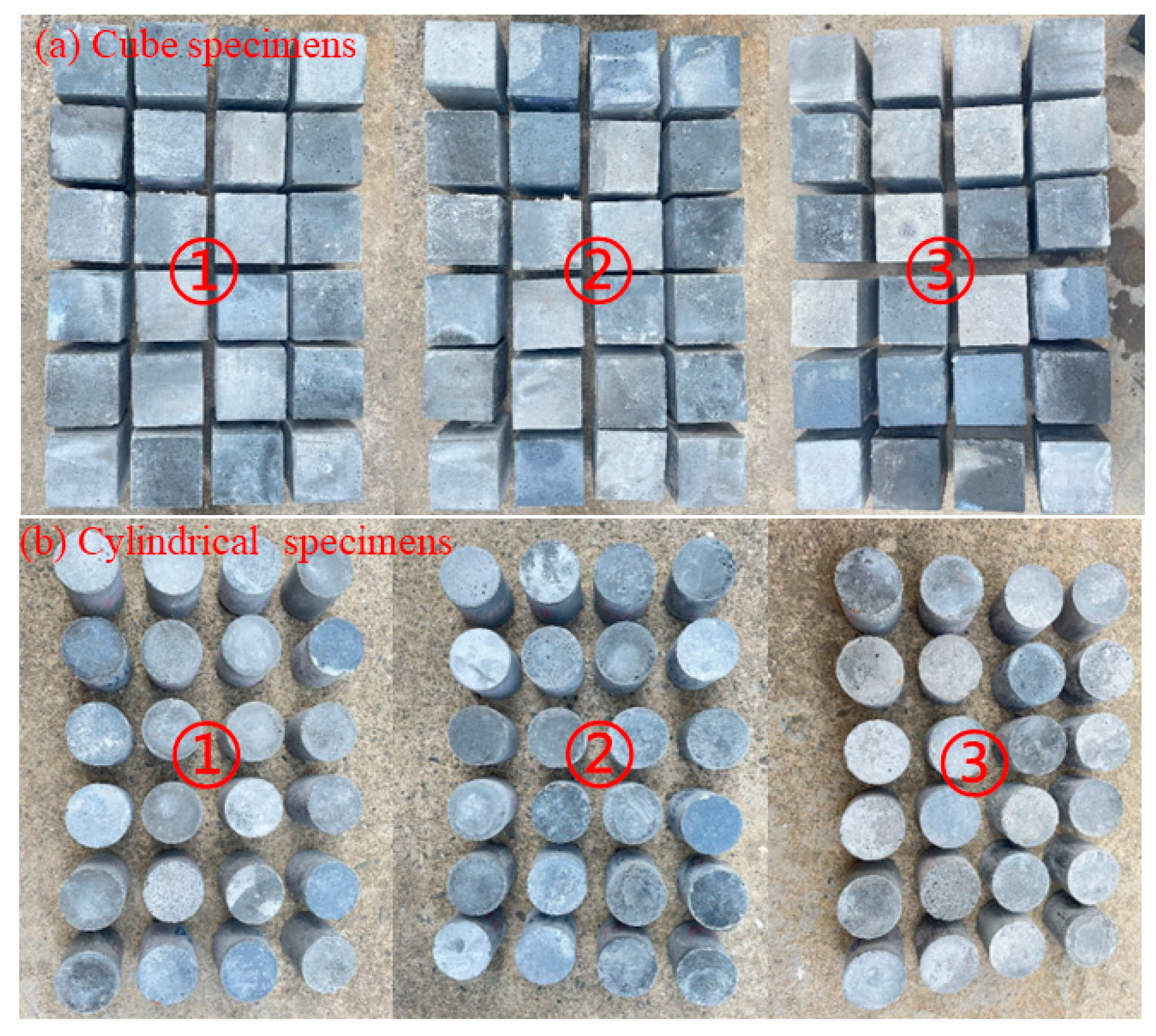
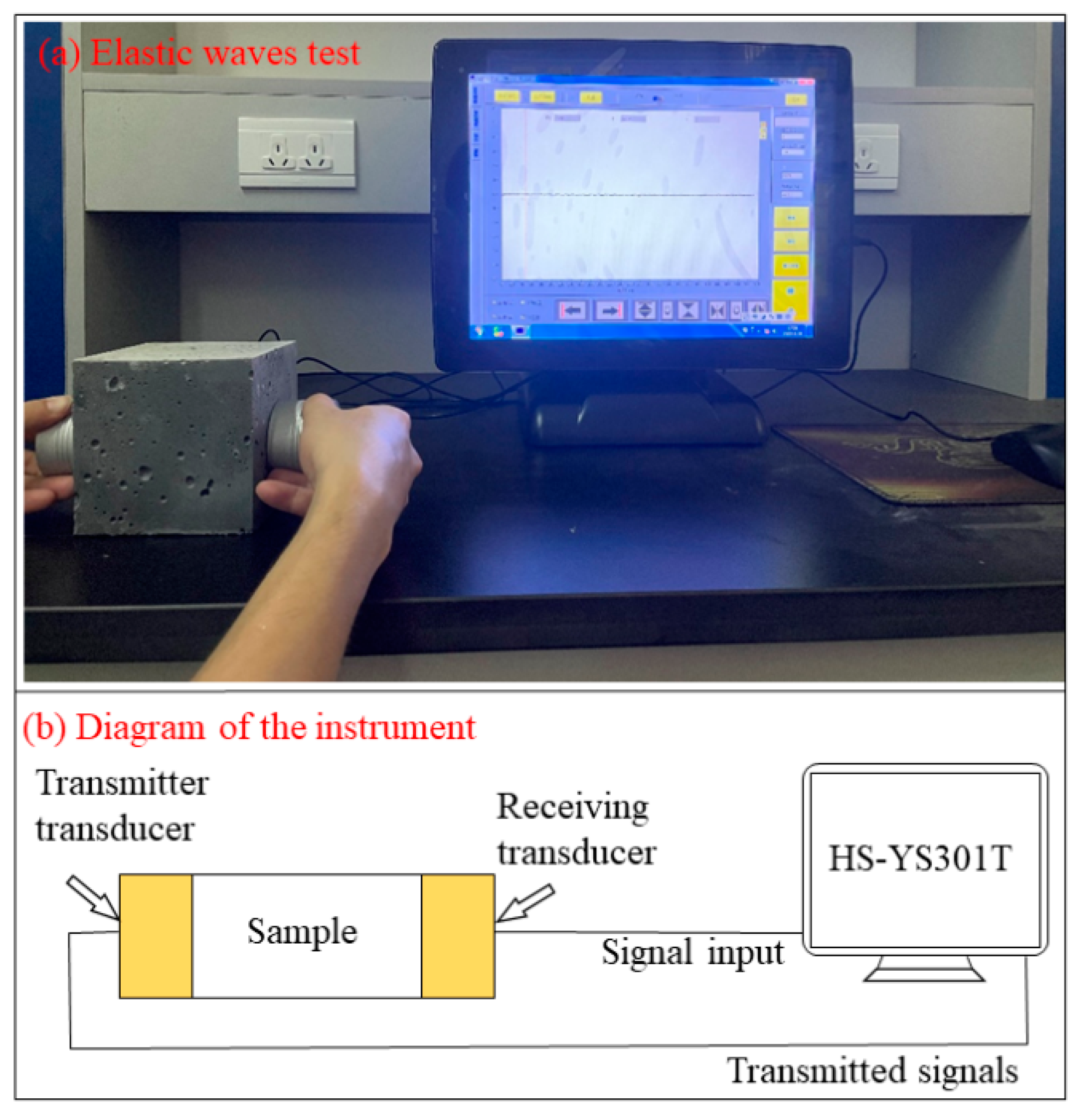
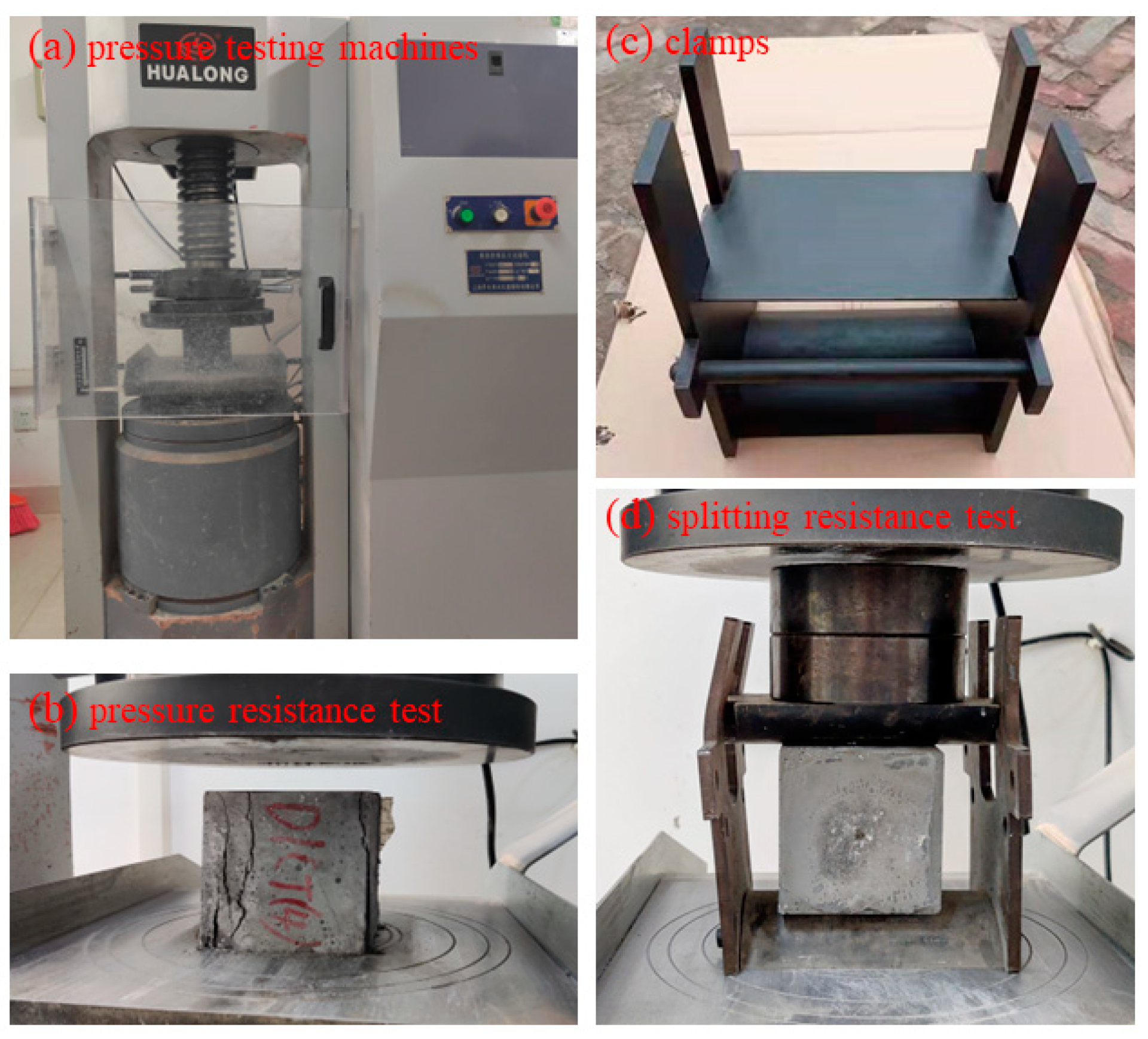

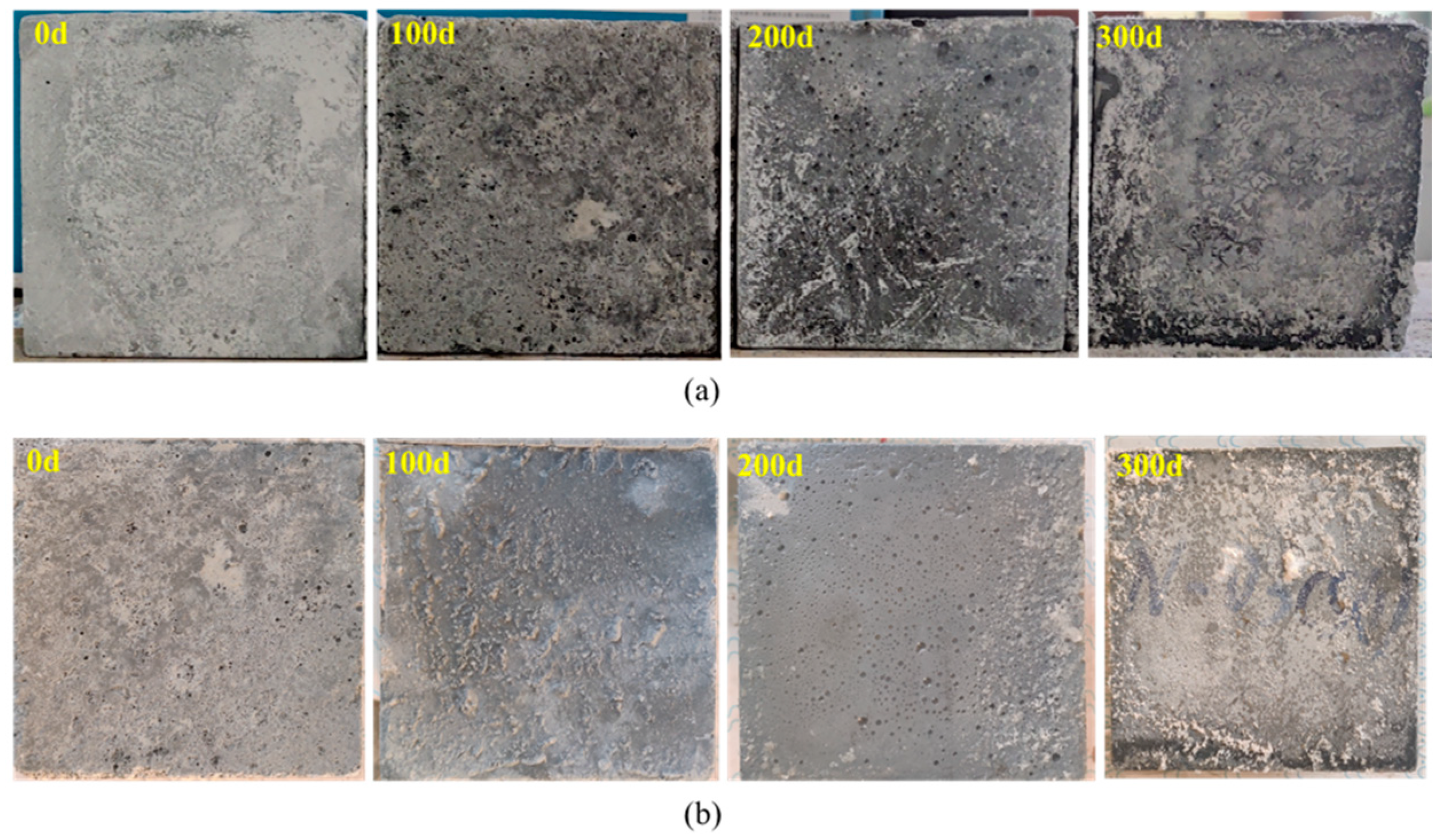
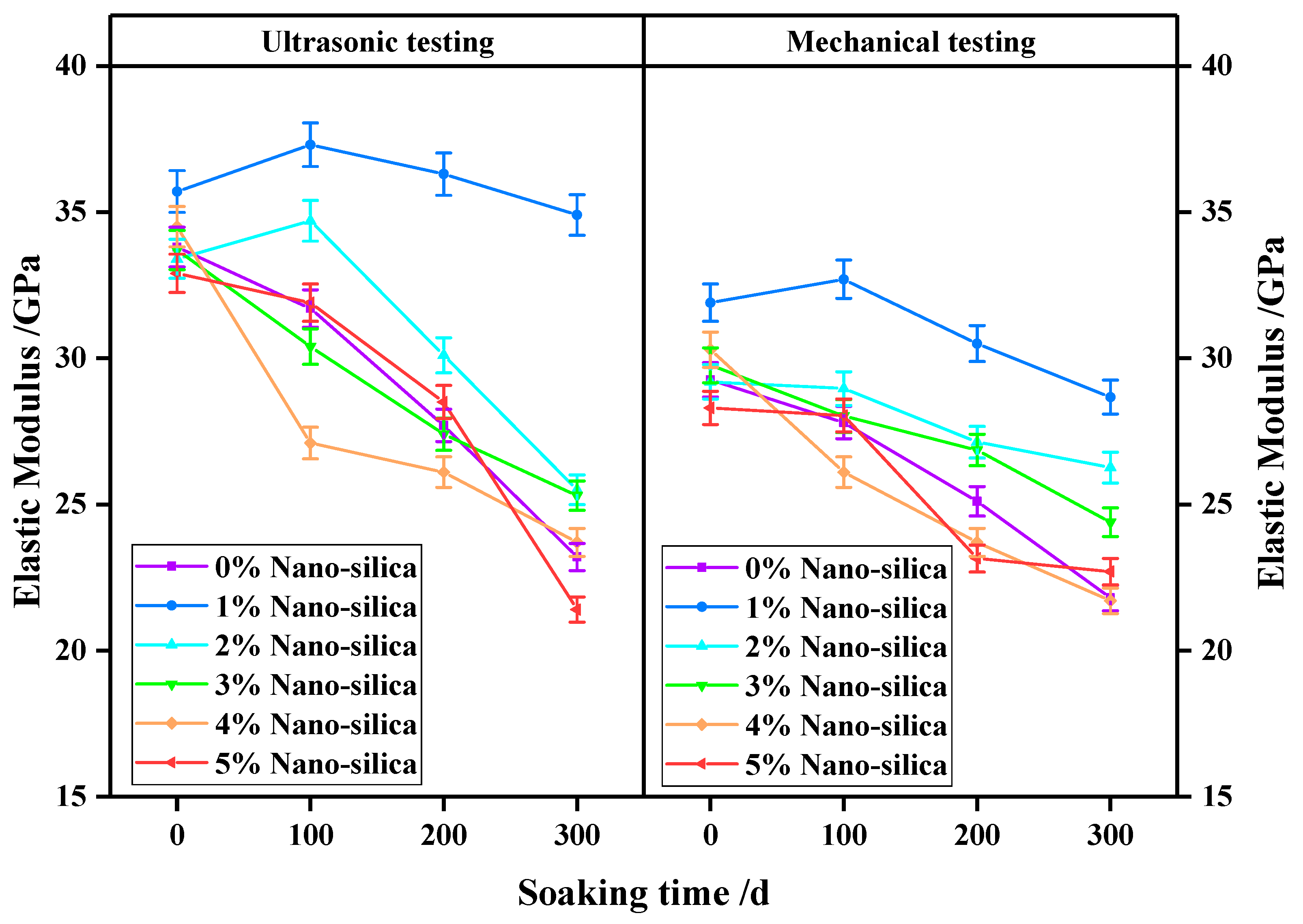
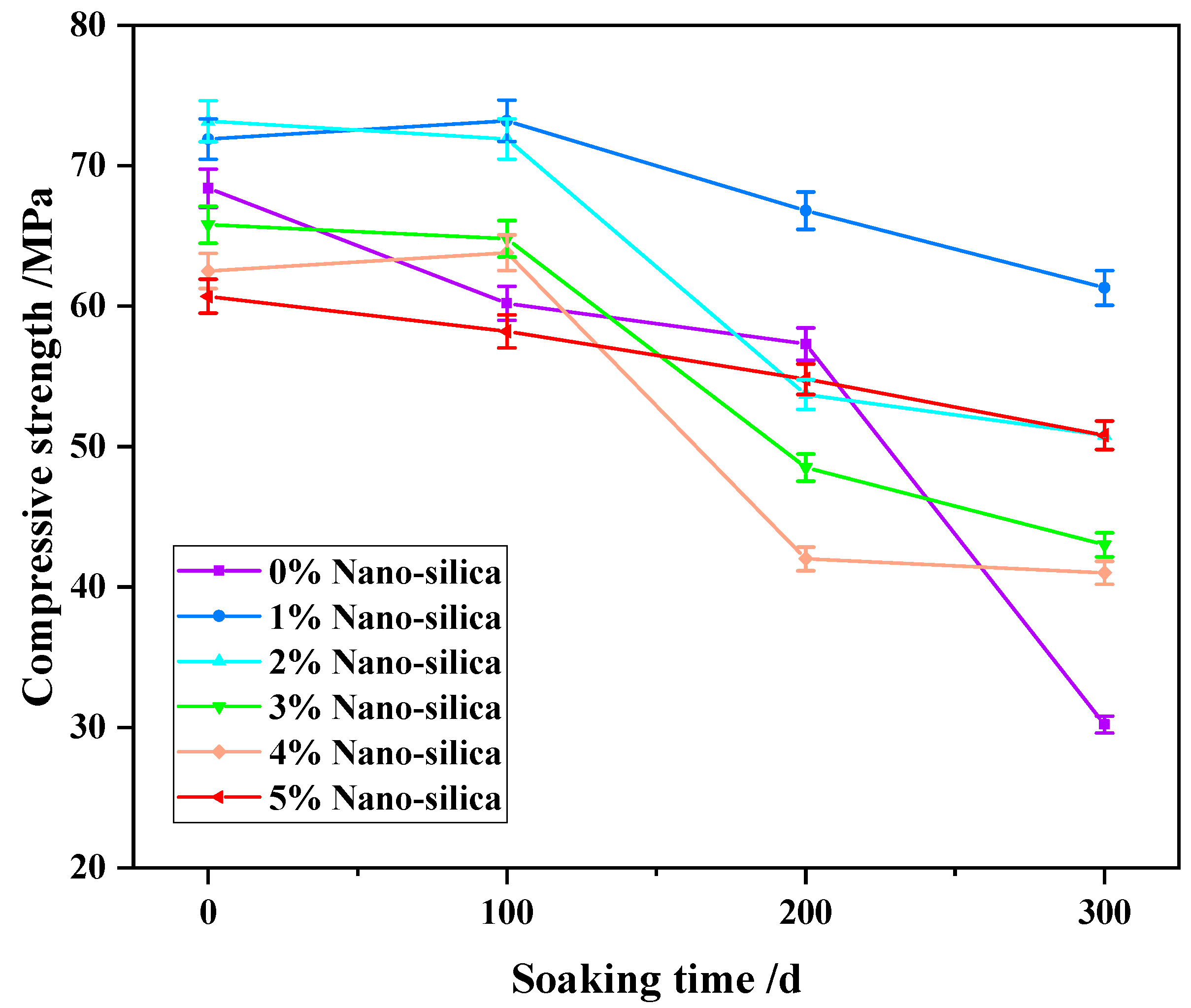
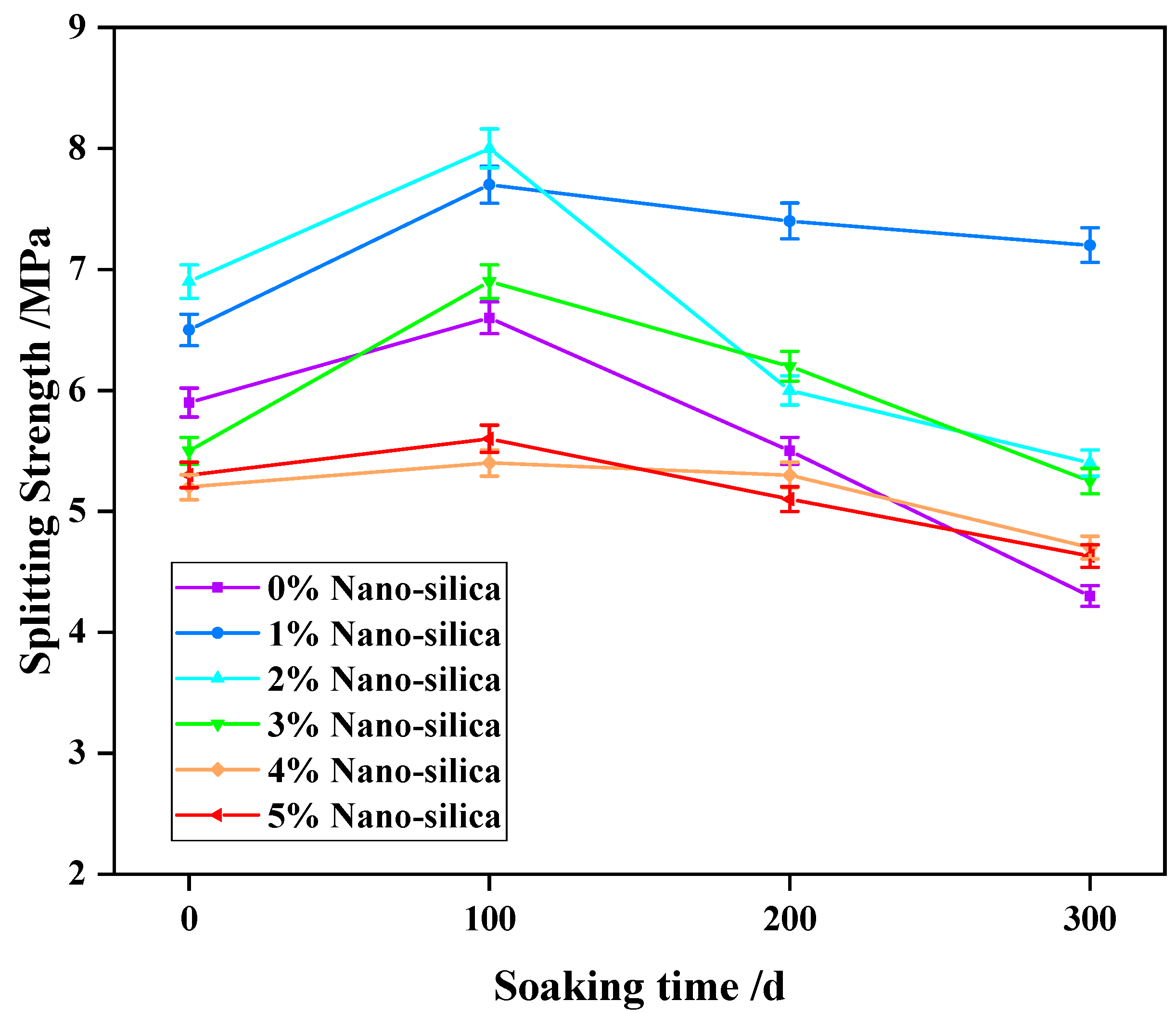
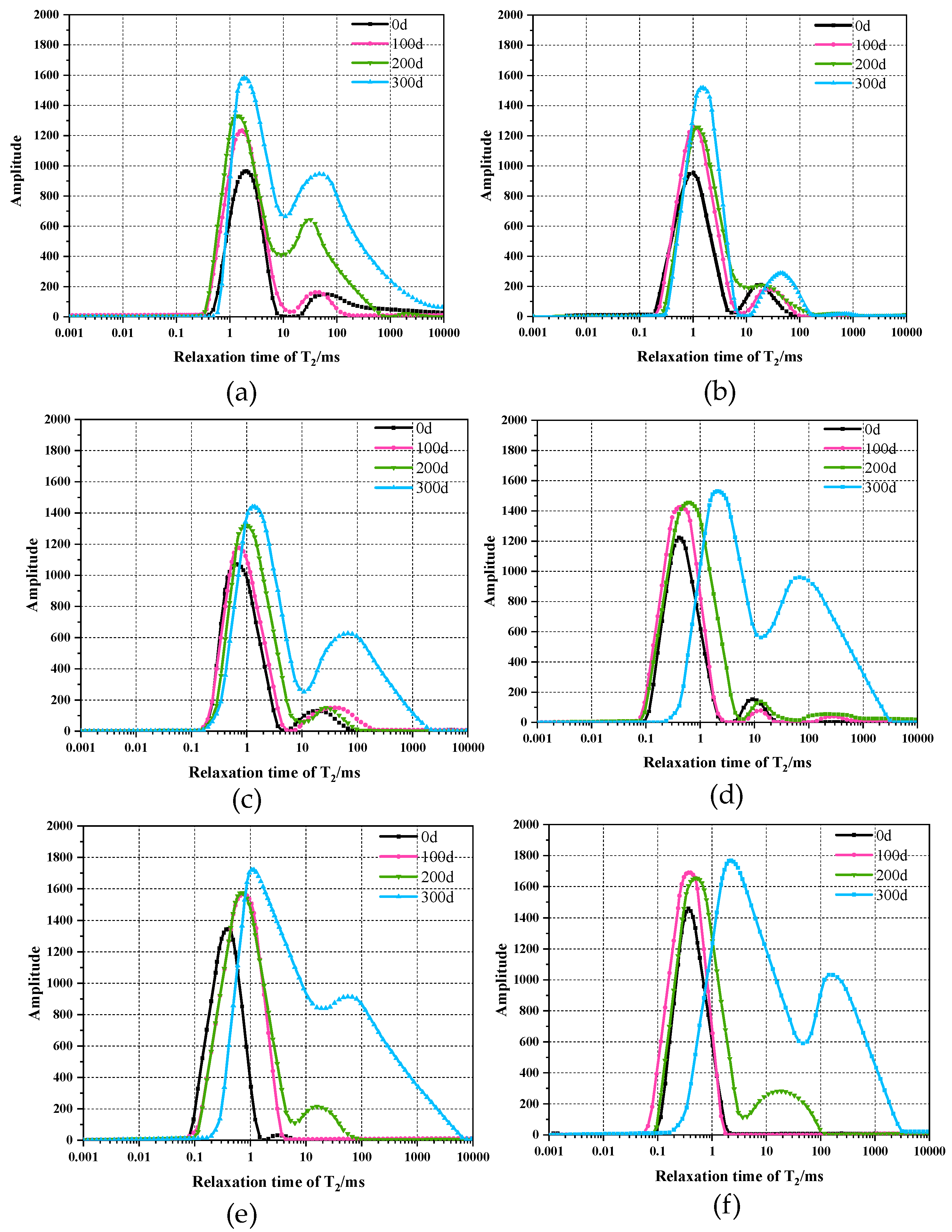

| Material | Chemical Compositions | Mineral Composition | ||||||||||
|---|---|---|---|---|---|---|---|---|---|---|---|---|
| SiO2 | Al2O3 | CaO | Fe2O3 | MgO | SO3 | Na2O | K2O | C3S | C2S | C3A | C4AF | |
| Cement | 21.34 | 4.84 | 63.61 | 3.43 | 1.26 | 2.45 | 0.16 | 1.12 | 48.19 | 22.64 | 7.03 | 10.43 |
| Fly ash | 69.17 | 6.94 | 10.52 | 7.47 | 1.16 | 0.11 | 2.13 | 1.26 | - | |||
| Silica fume | 98.08 | 0.34 | 0.12 | 0.04 | 0.34 | 0.42 | - | - | ||||
| Size (nm) | Specific Surface Area (m2/g) | Volume Density (g/cm3) | Density (g/cm3) | Color |
|---|---|---|---|---|
| 20 | 240 | 0.06 | 2.2–2.6 | white |
| Number | Cement | Fly Ash | Silica Fume | Quartz Sand | Water | Water-Reducer | Nano-Silica |
|---|---|---|---|---|---|---|---|
| NS-0-m-n | 900 | 50 | 50 | 1100 | 250 | 8 | 0 |
| NS-1-m-n | 891 | 50 | 50 | 1100 | 250 | 8 | 9 |
| NS-2-m-n | 882 | 50 | 50 | 1100 | 250 | 8 | 18 |
| NS-3-m-n | 873 | 50 | 50 | 1100 | 250 | 8 | 27 |
| NS-4-m-n | 864 | 50 | 50 | 1100 | 250 | 8 | 36 |
| NS-5-m-n | 855 | 50 | 50 | 1100 | 250 | 8 | 45 |
Publisher’s Note: MDPI stays neutral with regard to jurisdictional claims in published maps and institutional affiliations. |
© 2022 by the authors. Licensee MDPI, Basel, Switzerland. This article is an open access article distributed under the terms and conditions of the Creative Commons Attribution (CC BY) license (https://creativecommons.org/licenses/by/4.0/).
Share and Cite
Nie, L.; Li, X.; Li, J.; Zhu, B.; Lin, Q. Analysis of High Performance Concrete Mixed with Nano-Silica in Front of Sulfate Attack. Materials 2022, 15, 7614. https://doi.org/10.3390/ma15217614
Nie L, Li X, Li J, Zhu B, Lin Q. Analysis of High Performance Concrete Mixed with Nano-Silica in Front of Sulfate Attack. Materials. 2022; 15(21):7614. https://doi.org/10.3390/ma15217614
Chicago/Turabian StyleNie, Lianfei, Xiangdong Li, Jing Li, Baolong Zhu, and Qi Lin. 2022. "Analysis of High Performance Concrete Mixed with Nano-Silica in Front of Sulfate Attack" Materials 15, no. 21: 7614. https://doi.org/10.3390/ma15217614
APA StyleNie, L., Li, X., Li, J., Zhu, B., & Lin, Q. (2022). Analysis of High Performance Concrete Mixed with Nano-Silica in Front of Sulfate Attack. Materials, 15(21), 7614. https://doi.org/10.3390/ma15217614






